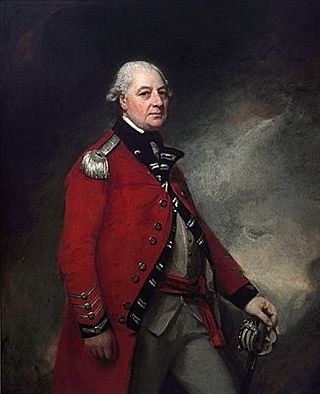Related Research Articles

Earl of Wemyss is a title in the Peerage of Scotland created in 1633. The Scottish Wemyss family had possessed the lands of Wemyss in Fife since the 12th century. Since 1823 the earldom has been held with the Earldom of March, created in 1697. The holder of the title is sometimes known as the Earl of Wemyss and March, but the titles are distinct.

Earl of Powis (Powys) is a title that has been created three times. The first creation came in the Peerage of England in 1674 in favour of William Herbert, 3rd Baron Powis, a descendant of William Herbert, 1st Earl of Pembroke. In 1687, he was further honoured when he was made Marquess of Powis.

Earl Annesley, of Castlewellan in the County of Down, is a title in the Peerage of Ireland. It was created on 17 August 1789 for Francis Annesley, 2nd Viscount Glerawly, with special remainder to his younger brother the Honourable Richard Annesley. He had previously represented Downpatrick in the Irish House of Commons. The titles of Baron Annesley, of Castlewellan in the County of Down, and Viscount Glerawly, in the County of Fermanagh, were created in the Peerage of Ireland on 20 September 1758 and 14 November 1766 respectively for his father William Annesley, who sat as Member of the Irish Parliament for Midleton. Annesley was the sixth son of the Honourable Francis Annesley, fourth son of Francis Annesley, 1st Viscount Valentia.

Baron Farnham, of Farnham in the County of Cavan, is a title in the Peerage of Ireland. It was created in 1756 for John Maxwell, who had previously represented Cavan Borough in the Irish House of Commons. John Maxwell's son, the second Baron, was created Viscount Farnham in 1760 and Earl of Farnham in 1763. Both titles were in the Peerage of Ireland but became extinct when he died childless in 1779. His brother and successor, the third Baron, was again created Viscount Farnham in 1781 and Earl of Farnham in 1785. These titles were also in the Peerage of Ireland. His son, the second Earl, sat in the House of Lords as an Irish representative peer from 1816 to 1823. However, he had no children and on his death in 1823 the viscountcy and earldom became extinct.

Field Marshal George Townshend, 1st Marquess Townshend, PC, known as The Viscount Townshend from 1764 to 1787, was a British soldier and politician. After serving at the Battle of Dettingen during the War of the Austrian Succession and the Battle of Culloden during the Jacobite Rising, Townshend took command of the British forces for the closing stages of the Battle of the Plains of Abraham during the Seven Years' War. He went on to be Lord Lieutenant of Ireland or Viceroy where he introduced measures aimed at increasing the size of Irish regiments, reducing corruption in Ireland and improving the Irish economy. In cooperation with Prime Minister North in London, he solidified governmental control over Ireland. He also served as Master-General of the Ordnance, first in the North Ministry and then in the Fox–North Coalition.

Field Marshal Frederick Rudolph Lambart, 10th Earl of Cavan, known as Viscount Kilcoursie from 1887 until 1900, was a British Army officer who served as chief of the imperial general staff (CIGS), the professional head of the British Army, in the 1920s. After being commissioned into the Grenadier Guards in 1885, he served in the Second Boer War as a company commander, then served with distinction during the First World War as a brigade, divisional, corps, and army commander, and later advised the British government on the implementation of the Geddes report, which advocated a large reduction in defence expenditure; he presided over a major reduction in the size of the British Army.

Earl of Cavan is a title in the Peerage of Ireland. It was created in 1647 for Charles Lambart, 2nd Baron Lambart. He was made Viscount Kilcoursie, in the King's County, at the same time, also in the Peerage of Ireland. Lord Cavan was the son of Oliver Lambart, who had been elevated to the Peerage of Ireland as Lord Lambart, Baron of Cavan in the County of Cavan, in 1618.

George Waldegrave, 4th Earl Waldegrave, PC was a British Army officer and politician who sat in the British House of Commons from 1774 to 1780.

Richard Ford William Lambart, 7th Earl of Cavan, styled Viscount Kilcoursie from 1772 to 1778, was a British military commander throughout the Napoleonic era and beyond.

Frederick Edward Gould Lambart, 9th Earl of Cavan KP, PC, DL, JP styled Viscount Kilcoursie until 1887, was an Anglo-Irish Royal Navy officer and Liberal politician. He served as Vice-Chamberlain of the Household in 1886 in William Ewart Gladstone's third administration.
Ford Lambart, 5th Earl of Cavan (1718–1772) was an Irish peer and freemason.

General George Augustus Herbert, 11th Earl of Pembroke and 8th Earl of MontgomeryKG, PC was an English peer, army officer, and politician.
William FitzMaurice, 2nd Earl of Kerry PC (Ire) was a British Army officer and peer.
Charles Lambart, 3rd Earl of Cavan was an Irish peer.
Lambart is a surname. Notable people with the surname include:
General Sir James Steuart Denham, 8th and 4th Baronet was a Scottish soldier of the British Army.
James Johnston was a general of the British Army, colonel of the Royal Horse Guards then colonel of the Scots Greys where he succeeded his sister's husband, George Preston.
George Forbes, 4th Earl of Granard was an Irish soldier and politician.

Charles Lambart, 1st Earl of Cavan was an Anglo-Irish Royalist soldier and peer.
Henry Theophilus Clements PC(I) was an Anglo-Irish soldier, politician and official in the Dublin Castle administration in Ireland.
References
- ↑ "55th Regiment of Foot-Richard Lambart, 6th Earl of Cavan". British Empire (Stephen Luscombe]. Retrieved 6 July 2016.
- 1 2 Lodge, John. The Peerage of Ireland:Volume I. p. 361.
- ↑ A New System of Military Discipline, Founded Upon Principle. R. Aitken. ISBN 978-0-608-43158-1.